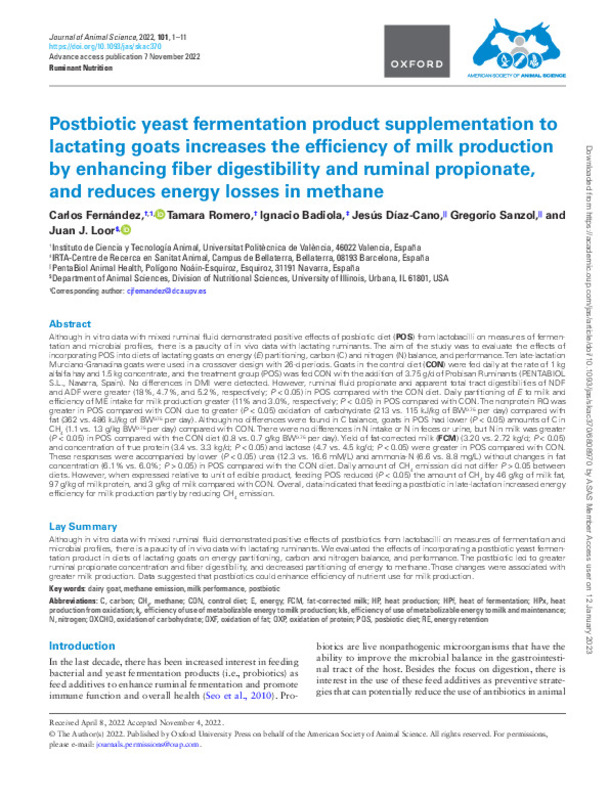|
Resumen:
|
[EN] Lay Summary Although in vitro data with mixed ruminal fluid demonstrated positive effects of postbiotics from lactobacilli on measures of fermentation and microbial profiles, there is a paucity of in vivo data with ...[+]
[EN] Lay Summary Although in vitro data with mixed ruminal fluid demonstrated positive effects of postbiotics from lactobacilli on measures of fermentation and microbial profiles, there is a paucity of in vivo data with lactating ruminants. We evaluated the effects of incorporating a postbiotic yeast fermentation product in diets of lactating goats on energy partitioning, carbon and nitrogen balance, and performance. The postbiotic led to greater ruminal propionate concentration and fiber digestibility, and decreased partitioning of energy to methane. Those changes were associated with greater milk production. Data suggested that postbiotics could enhance efficiency of nutrient use for milk production.
Although in vitro data with mixed ruminal fluid demonstrated positive effects of posbiotic diet (POS) from lactobacilli on measures of fermentation and microbial profiles, there is a paucity of in vivo data with lactating ruminants. The aim of the study was to evaluate the effects of incorporating POS into diets of lactating goats on energy (E) partitioning, carbon (C) and nitrogen (N) balance, and performance. Ten late-lactation Murciano-Granadina goats were used in a crossover design with 26-d periods. Goats in the control diet (CON) were fed daily at the rate of 1 kg alfalfa hay and 1.5 kg concentrate, and the treatment group (POS) was fed CON with the addition of 3.75 g/d of Probisan Ruminants (PENTABIOL S.L., Navarra, Spain). No differences in DMI were detected. However, ruminal fluid propionate and apparent total tract digestibilities of NDF and ADF were greater (18%, 4.7%, and 5.2%, respectively; P < 0.05) in POS compared with the CON diet. Daily partitioning of E to milk and efficiency of ME intake for milk production greater (11% and 3.0%, respectively; P < 0.05) in POS compared with CON. The nonprotein RQ was greater in POS compared with CON due to greater (P < 0.05) oxidation of carbohydrate (213 vs. 115 kJ/kg of BW0.75 per day) compared with fat (362 vs. 486 kJ/kg of BW0.75 per day). Although no differences were found in C balance, goats in POS had lower (P < 0.05) amounts of C in CH4 (1.1 vs. 1.3 g/kg BW0.75 per day) compared with CON. There were no differences in N intake or N in feces or urine, but N in milk was greater (P < 0.05) in POS compared with the CON diet (0.8 vs. 0.7 g/kg BW0.75 per day). Yield of fat-corrected milk (FCM) (3.20 vs. 2.72 kg/d; P < 0.05) and concentration of true protein (3.4 vs. 3.3 kg/d; P < 0.05) and lactose (4.7 vs. 4.5 kg/d; P < 0.05) were greater in POS compared with CON. These responses were accompanied by lower (P < 0.05) urea (12.3 vs. 16.6 mM/L) and ammonia-N (6.6 vs. 8.8 mg/L) without changes in fat concentration (6.1% vs. 6.0%; P > 0.05) in POS compared with the CON diet. Daily amount of CH4 emission did not differ P > 0.05 between diets. However, when expressed relative to unit of edible product, feeding POS reduced (P < 0.05) the amount of CH4 by 46 g/kg of milk fat, 97 g/kg of milk protein, and 3 g/kg of milk compared with CON. Overall, data indicated that feeding a postbiotic in late-lactation increased energy efficiency for milk production partly by reducing CH4 emission.
Our results demonstrate that feeding a postbiotic in late-lactation can increase energy efficiency for milk production in part by enhancing ruminal production of propionate and reducing methane emission.
[-]
|









